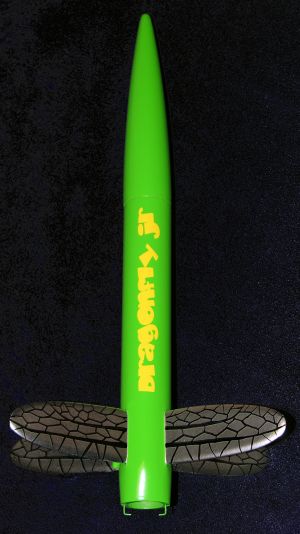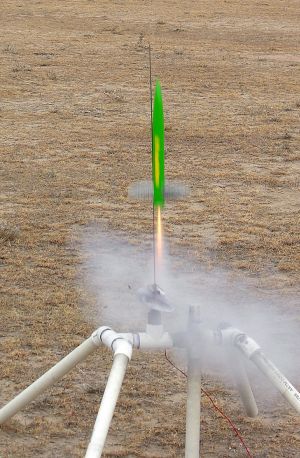Scratch Dragonfly Jr. Original Design / Scratch Built
Scratch - Dragonfly Jr. {Scratch}
Contributed by Geof Givens
| Manufacturer: | Scratch |

Brief:
The Dragonfly Jr is an approximate 50% downscale of the stylish
Binder
Design Dragonfly. This project was conceived as a way to explore the
long-burn 24mm RMS motors with a design I have always admired. I added a few of
my own touches as well, including a bit extra length to squeeze in a baffle and
nylon chute, and a unique asymmetric boat tail.
Construction:
Here is a parts list:
- 7.5in BT-55 tube
- long BT-55 nose cone (mine is 6 3/8")
- cardstock transition template (d1=1.1", d2=1.35", len=1.02")
- 3/32" balsa fin stock
- BT-50 motor mount tube
- 2 BT-50 to BT-55 centering rings
- BT-50 engine block
- 2 standard engine clips
- Semroc BT-55 baffle kit
- 15in Top Flight rip stop nylon X-form parachute
- Kevlar® string
- screw eye
- nose weight (optional)
Assemble the engine block, motor mount tube, centering rings, and engine clips in the standard way except as follows. First, the motor tube extends 1" beyond the base of the airframe, so make sure the centering rings are positioned inside the main body with the lower one at the base of the airframe. Second, if you choose through-the-wall fin mounting (see below), then the forward centering ring must be high enough not to interfere with the fin tabs. Third, file away the forward clips of the motor retainers, so they don't interfere with a RMS case. Finally, sand the inside of the engine block to ensure that a RMS case slides easily into position.
I slotted the body tube starting 1/8" above the aft end, providing for through-the-wall fin mounting. I opted for angles of 50, 130, 50, and 130 for the Dragonfly look. Out of respect for Mike Fisher at Binder Design, I won't report the fin dimensions, but you can eyeball them or email him. He was extremely helpful. I used the ancient method involving string, two pushpins, and a pencil to draw ellipses. (For those not well-versed in ancient Greek geometry, I'm told that one of those modern electric thingies with a keyboard and mouse can also draw ellipses.) The fins are beveled, and I tried a new finishing strategy: one coat of diluted yellow glue followed by two coats of diluted Elmer's Fill 'n' Finish with sanding between each coat. This yielded fins and a nose cone that were rock hard and silky smooth.
For through-the-wall fin mounting, glue in the motor mount with the rear centering ring only dry fit (with tape tabs for later removal). When the glue dries, extract the rear ring and glue the fins in place with interior and exterior fillets. Then glue the rear ring back in place.
The transition shroud can be glued with no seam ridge by layering a backing behind the seam and removing any tab in your template. This shroud then fits over the tail of the rocket down to the end of the motor tube. The dimensions given above will not make a tight seal at the aft end of the motor tube because some slack is needed for the asymmetric tail. Glue the shroud only to the main airframe. When the glue dries, carefully deform the narrow end of the shroud and use CA glue to tack it to the motor tube only at two opposing points. I made it so that the flatter sides of the tail line up with the wider between-fin angles (see the photo). The rear gaps in the tail can be filled with tissue, balsa scraps, filler, and glue, but leave room for the clips to wiggle.
The rest is pretty standard: launch lug, baffle (at least 2.25in gap between the bottom of the baffle and the top of the motor tube because RMS motors extend a long way up), screw eye, Kevlar®, and parachute.
Attach the Kevlar® to the baffle before inserting the baffle to prevent headaches later.
Finishing:
The finish is Duplicolor Engine Enamel Ceramic Grabber Green and Rustoleum
Silver with Walmart clear overcoat. The fin detail was done with some Google
searching, several hours of practice on paper first to get a good look, and a
Sharpie marker. Mike Fisher at Binder Design has been supportive throughout
this project and he sold me a beautiful downscale vinyl sticker exactly to my
specifications at a very affordable price. The final look is very clean.
Flight and Recovery:
After I built this rocket, I simmed it in RockSim and realized I would likely
lose it on a long burn F. Here are some simulated results:
| Motor | Height (ft) |
|---|---|
| C6 | 725 |
| D12 | 1435 |
| E11 | 2738 (with 0.25oz nose weight) |
| F12 | 3268 (with 0.5oz nose weight) |

I decided to add 0.75 oz nose weight to keep this Dragonfly from flying too high. That made the total weight 3 3/8oz.
The first launch was on a beautiful fall day out in the prairie. With an old D-motor casing as an adaptor, I loaded a C6-5 for the first flight as I was determined not to lose it. Dragonfly Jr. shot up every bit of 725 feet if not 900. Boost was a little squirrelly but vertical. Ejection was a bit early and descent was swift on the small chute.
Next, I decided to try a D12-5 (not having any longer delays handy). This is when I made a major mistake: I let my wife hold the rocket. She promptly dropped it and broke a fin. Dragonfly Jr. was done for the day. I'll repair it and update more flights in the coming months.
Summary:
This project is highly recommendable, but the rocket is so light that it might
be better to build it as 18mm or to buy the larger 29mm Binder Design version.
 |
 |